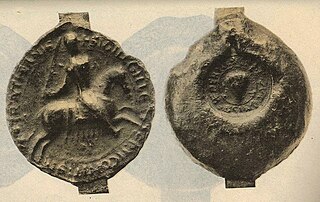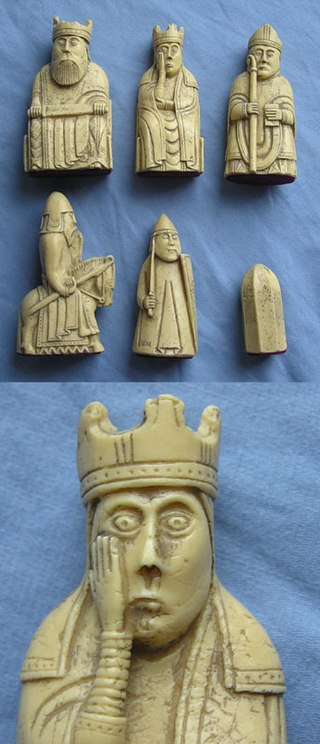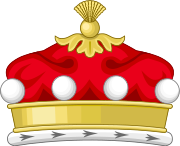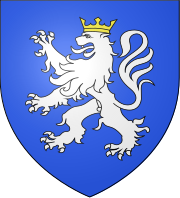
Malcolm IV, nicknamed Virgo, "the Maiden" was King of Scotland from 1153 until his death. He was the eldest son of Henry, Earl of Huntingdon and Northumbria and Ada de Warenne. The original Malcolm Canmore, a name now associated with his great-grandfather Malcolm III, succeeded his grandfather David I, and shared David's Anglo-Norman tastes.

Máel Coluim mac Cináeda was King of Alba (Scotland) from 1005 until his death in the year 1034. He was one of the longest-reigning Scottish kings of that period.

The title Earl of Moray, Mormaer of Moray or King of Moray was originally held by the rulers of the Province of Moray, which existed from the 10th century with varying degrees of independence from the Kingdom of Alba to the south. Until 1130 the status of Moray's rulers was ambiguous and they were described in some sources as "mormaers", in others as "Kings of Moray", and in others as "Kings of Alba". The position was suppressed by David I of Scotland some time after his defeat of Óengus of Moray at the Battle of Stracathro in 1130, but was recreated as a feudal earldom by Robert the Bruce and granted to Thomas Randolph, 1st Earl of Moray in 1312.

Earl of Carrick is the title applied to the ruler of Carrick, subsequently part of the Peerage of Scotland. The position came to be strongly associated with the Scottish crown when Robert the Bruce, who had inherited it from his maternal kin, became King of the Scots in the early 14th century. Since the 15th century, the title of Earl of Carrick has automatically been held by the heir apparent to the throne, thus the current holder of the title is Prince William, Duke of Rothesay.

Lord of the Isles or King of the Isles (Scottish Gaelic: Triath nan Eilean or Rìgh Innse Gall) is a title of Scottish nobility with historical roots that go back beyond the Kingdom of Scotland. It began with Somerled in the 12th century and thereafter the title was held by a series of his descendants, the Norse-Gaelic rulers of the Isle of Man and Argyll and the islands of Scotland in the Middle Ages. They wielded sea-power with fleets of galleys (birlinns). Although they were, at times, nominal vassals of the kings of Norway, Ireland, or Scotland, the island chiefs remained functionally independent for many centuries. Their territory included much of Argyll, the Isles of Arran, Bute, Islay, the Isle of Man, Hebrides, Knoydart, Ardnamurchan, and the Kintyre peninsula. At their height they were the greatest landowners and most powerful lords after the kings of England and Scotland.
Uhtred mac Fergus was Lord of Galloway from 1161 to 1174, ruling jointly with his brother Gille Brigte (Gilbert). They were sons of Fergus of Galloway; it was believed that they were half brothers, but Duncan of Carrick was addressed as cousin by the English King, as was Uchtred.. Their mother's name is not known for sure, but she must have been one of the many illegitimate daughters of Henry I of England, most likely Elizabeth Fitzroy.

Fergus of Galloway was a twelfth-century Lord of Galloway. Although his familial origins are unknown, it is possible that he was of Norse-Gaelic ancestry. Fergus first appears on record in 1136, when he witnessed a charter of David I, King of Scotland. There is considerable evidence indicating that Fergus was married to an illegitimate daughter of Henry I, King of England. It is possible that Elizabeth Fitzroy was the mother of Fergus's three children.
Lochlann of Galloway, also known as Lochlan mac Uchtred and by his French name Roland fitz Uhtred, was the son and successor of Uchtred, Lord of Galloway as the "Lord" or "sub-king" of eastern Galloway.
Gille Brigte or Gilla Brigte mac Fergusa of Galloway, also known as Gillebrigte, Gille Brighde, Gilbridge, Gilbride, etc., and most famously known in French sources as Gilbert, was Lord of Galloway of Scotland. Gilla Brigte was one of two sons of the great Fergus, the builder of the "Kingdom" of Galloway.

Donnchadh was a Gall-Gaidhil prince and Scottish magnate in what is now south-western Scotland, whose career stretched from the last quarter of the 12th century until his death in 1250. His father, Gille-Brighde of Galloway, and his uncle, Uhtred of Galloway, were the two rival sons of Fergus, Prince or Lord of Galloway. As a result of Gille-Brighde's conflict with Uhtred and the Scottish monarch William the Lion, Donnchadh became a hostage of King Henry II of England. He probably remained in England for almost a decade before returning north on the death of his father. Although denied succession to all the lands of Galloway, he was granted lordship over Carrick in the north.
Suibne mac Cináeda was an eleventh-century ruler of the Gall Gaidheil, a population of mixed Scandinavian and Gaelic ethnicity. There is little known of Suibne as he is only attested in three sources that record the year of his death. He seems to have ruled in a region where Gall Gaidheil are known to have dwelt: either the Hebrides, the Firth of Clyde region, or somewhere along the south-western coast of Scotland from the Firth of Clyde southwards into Galloway.

Gille Brigte of Strathearn (1150–1223), sometimes also called Gilbert, was the 3rd Earl or Mormaer of Strathearn.
Moray was a province within the area of modern-day Scotland, that may at times up to the 12th century have operated as an independent kingdom or as a power base for competing claimants to the Kingdom of Alba. It covered a much larger territory than the modern council area of Moray, extending approximately from the River Spey in the east to the River Beauly in the north, and encompassing Badenoch, Lochaber and Glenelg in the south and west.
Findláech mac Ruaidrí, son of Ruaidrí mac Donald, was the minor "king", locally called "Mormaer", of Moray, in the north of modern-day Scotland, from some point before 1014 until his death in 1020. Findláech's son Macbethad mac Findláech, was made famous as the protagonist of William Shakespeare's play Macbeth.
Máel Coluim mac Máil Brigti was King or Mormaer of Moray (1020–1029), and, as his name suggests, the son of a Máel Brigte. As with his predecessor Findláech mac Ruaidrí, sources call him "King of Scotland."

The High Middle Ages of Scotland encompass Scotland in the era between the death of Domnall II in 900 AD and the death of King Alexander III in 1286, which was an indirect cause of the Wars of Scottish Independence.
Christian of Whithorn was Bishop of Whithorn (1154–1186), the second incumbent of that Episcopal See since it had been resurrected by King Fergus of Galloway earlier in the 12th century.
The Meic Uilleim (MacWilliams) were the Gaelic descendants of William fitz Duncan, grandson of Máel Coluim mac Donnchada, king of Scots. They were excluded from the succession by the descendants of Máel Coluim's son David I during the 12th century and raised a number of rebellions to vindicate their claims to the Mormaerdom of Moray and perhaps to the rule of Scotland.

Harald Maddadsson was Earl of Orkney and Mormaer of Caithness from 1139 until 1206. He was the son of Matad, Mormaer of Atholl, and Margaret, daughter of Earl Haakon Paulsson of Orkney. Of mixed Norse and Gaelic blood, and a descendant of Scots kings, he was a significant figure in northern Scotland, and played a prominent part in Scottish politics of the twelfth century. The Orkneyinga Saga names him one of the three most powerful Earls of Orkney along with Sigurd Eysteinsson and Thorfinn Sigurdsson.

Lincluden Collegiate Church, known earlier as Lincluden Priory or Lincluden Abbey, is a ruined religious house, situated in the historic county of Kirkcudbrightshire and to the north of the Royal Burgh of Dumfries, Scotland. Situated in a bend of the River Cairn, at its confluence with the River Nith, the ruins are on the site of the Bailey of the very early Lincluden Castle, as are those of the later Lincluden Tower. This religious house was founded circa 1160 and was used for various purposes, until its abandonment around 1700. The remaining ruins are protected as a scheduled monument.














